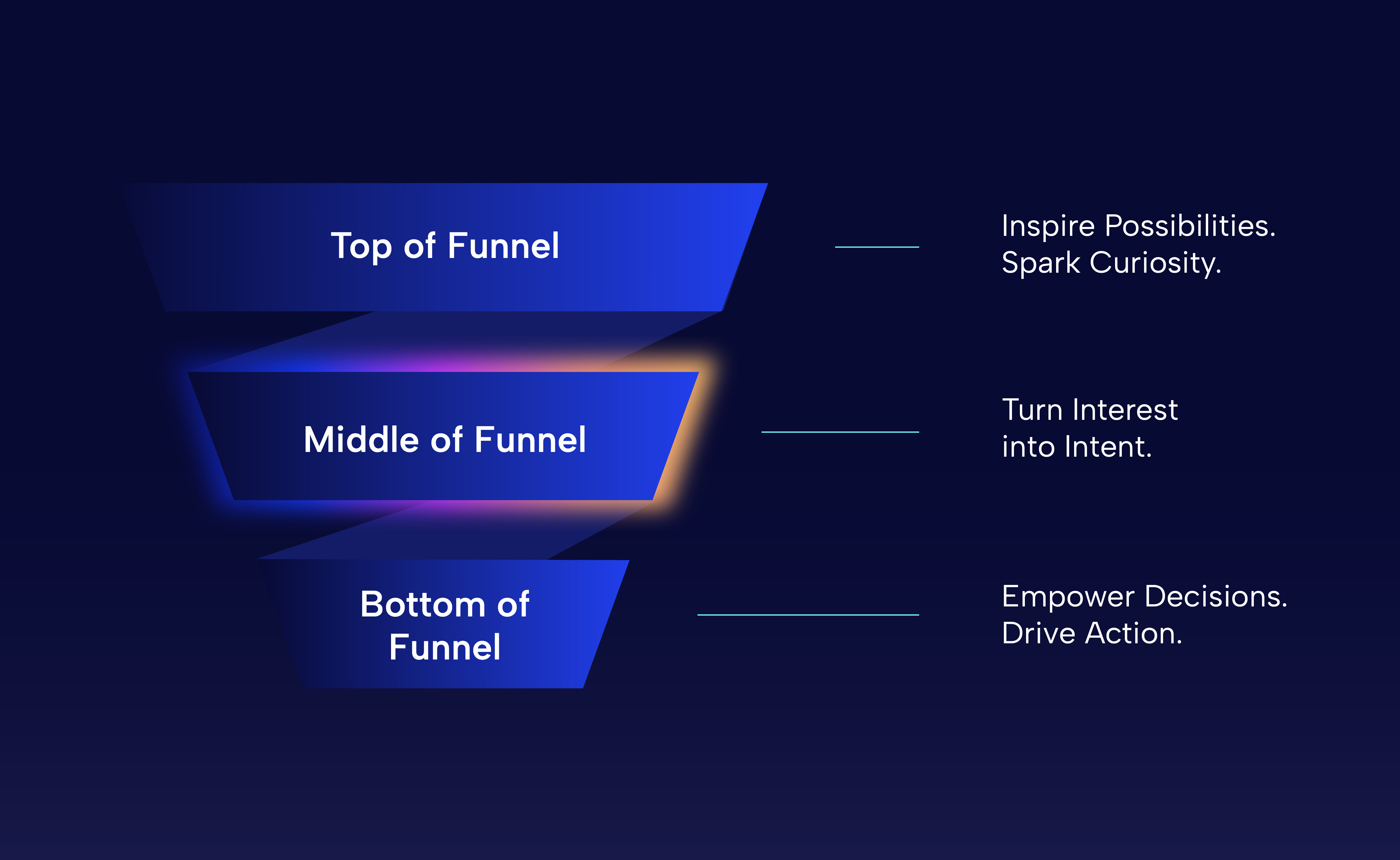B2B Lead Nurturing: The Power of Segmentation & Full-Funnel Activation
Approx 4 min. read

The word "nurture" comes from the Latin “nutrire”, meaning to feed or cherish. It is the same root from which we get "nutrition".
To nurture your leads effectively, you need to gradually "feed" them information about your brand over time, in the form of small touches. These touches are any form of communication that reminds leads of who you are and what you sell.
One study found that it takes an average of 12 touches to lead a prospect through to the end of your sales funnel.
At Ever Wonder, we specialize in Business-to-Business (B2B) marketing. If you really understand how it works, there's no magic. Success comes down to mastering the fundamentals.
Because B2B tends to have long buying cycles, good marketing is all about nurturing your leads over time.
Webinar: The Magic Behind B2B Lead Nurturing
Recently, we ran a webinar, on the topic of B2B Lead Nurturing. We are sharing some of our key takeaways with you below:
- The Importance of Segmentation
- Key Tactics for Segmentation
- Full Funnel Activation
- Driving Growth with the HubSpot Flywheel
Personalization: The Importance of Segmentation
People’s dietary needs vary from person to person. If you want to nurture your leads effectively, you should feed them the right diet for their needs.
That’s why segmenting your buyers into distinct groups is one of the most powerful tools a marketer has in their toolbox. It lets you customize the messaging behind your touches so that every lead hears something that resonates with them.
One study found that segmented email campaigns result in a 760% increase in revenue over a one-size-fits-all campaign. McKinsey notes that personalization often drives a 10 to 15 percent increase in revenue.
It's not hard to see why this is. If you want to nurture leads properly, you have to feed them with the right nutrition—the right messaging for them. You might sell the same piece of software to a private school headmaster and to a blue-collar auto worker, but it would not make sense to nurture them with the same touches.
There are three good ways to segment your audience:
- Firmographic
- Behavioral
- Psychographic
These three types of segmentation need not be done separately. It is often useful to combine them, leading to even more fine-grained customer profiles.
Firmographic
In this approach, you divide up your buyers based on specific company attributes—the properties of their firm. This includes factors like company size, industry, and revenue.
Behavioral
In this approach, you divide up prospects based on specific behaviors related to your product. This includes consumption patterns, the nuances of their user journey, and their level of engagement with your product.
Psychographic
In the psychographic approach, you segment your prospects based on self-reported psychological categories. These include factors like interests, lifestyle, and personality.
Segmentation: Key Tactics
It's always good to have some best practices for any marketing technique. Who wants to do things wrong, anyway?
One tip is to use lead scoring to prioritize your leads based on explicit (demographic / firmographic) and implicit (engagement) factors. If you segment by score, you can decide which prospects to pursue more vigorously. Lead scoring is something you can do manually, but software like HubSpot Lead Score will pay for itself pretty quickly.
Buyer personas are an effective tool for maximizing the value of your audience segmentation. Create detailed buyer personas to classify specific archetypes of buyers that you hope to engage with. Consider the firmographic, behavioral, and psychographic factors that differentiate them from other buyers.
Finally, identify and focus on product-qualified leads (PQLs). These are leads who already have some form of meaningful experience with your product, such as using a free trial or demo version. They are particularly valuable for early customer feedback.
Full Funnel Activation
The concept of nurturing leads is all about touches. If you take away just one thing from this article, remember what we said before: it takes 12 touches, on average, to reach an individual prospect.
That means most customers won't even consider you unless you communicate with them at least 12 times.
Sometimes marketing teams quit a campaign early. They see that they've sent three or four impressions to their leads, and nothing happened. Of course, nothing happened—those leads need a lot more nurturing!
The 12 touches can take place throughout the entire sales funnel:
-
At the Awareness stage, this can take place through social media, SEO, blogs, paid search, and even some outbound sales. This is largely trying to touch buyers indirectly, through channels outside your immediate sphere of control.
-
At the Engagement stage, touches happen through landing pages, emails, sales enablement materials, or your website. Here, buyers are aware of you and are engaging with your brand directly.
-
At the Consideration and Intent stages, in the middle of the funnel, lead scoring becomes more important. At this phase, leads have some sort of interest, and you should try to get a sense of just how interested each lead is.
-
Finally, at the Purchase stage at the bottom of the funnel, leads commit to purchasing your product. But the work is not done—successful businesses will continue to nurture customers, keeping in touch with personalized messaging and customer service, in order to retain them and to generate flywheel effects.
Your potential customers are hungry. If you don’t keep them well-fed, they might starve! But if you feed them properly throughout your entire funnel, they will be happy and engaged instead.
Driving Growth with the HubSpot Flywheel
Have you ever seen an old-fashioned locomotive from the 1800’s? Sometimes they have a big wheel attached called a flywheel. The point of the flywheel is to get it spinning really, really fast, so that it stores energy to be used later.
The metaphor of a flywheel comes in handy when thinking about marketing and growth.
We like to use the HubSpot Flywheel as a model for driving growth. In this model, growth relies on three interlocking components:
- Attract
- Delight
- Engage
First, you attract visitors with relevant, engaging, useful content that empowers learning. You want to earn their attention rather than force it.
Then you engage prospects by enabling them to interact with you on their terms. Ideally, you should align to their preferred channels and timelines, not the other way around. Here the goal is to build relationships.
Finally, you delight prospects by supporting them, enabling them to reach their goals, and building lasting partnerships. Here, customer success is your success.
If done right, delighted and engaged customers will help turn the flywheel by promoting your product themselves, through word-of-mouth referrals and reviews.
Summary: Divide and Nurture
Success in B2B marketing really comes down to taking care of the fundamentals really, really well.
Buyers in this space are typically operating over very long cycles. That's why it's important to nurture them over the long term.
This takes place through "touches" of all kinds—ads, blog articles, social media, direct outreach, and more. Anything that you can do to remind them that you exist can help.
In most cases, it will take at least a dozen touches to fully get through to a lead. That's why it's so important to be persistent. Canceling a good campaign after it generates three or four touches is probably too soon.
Be sure to segment your buyers so that each touch can be optimized for a specific user persona. One set of messaging will not work for all of your buyers.
Finally, use the power of your customers to your advantage. Generate growth through attracting, engaging, and delighting your prospects.
Interested in learning more about this approach? We are a HubSpot-certified platinum partner and experts in using their marketing software.
Contact us today to learn more about how our expertise could help drive growth for your business.
Related posts
Food for thought.

Turn Interest into Intent at the Middle of the Funnel to Shorten the Sales Cycle
by Conor Ebbs



